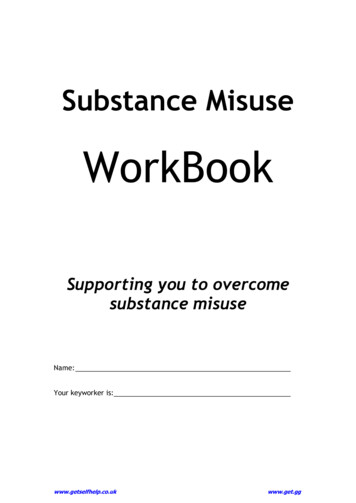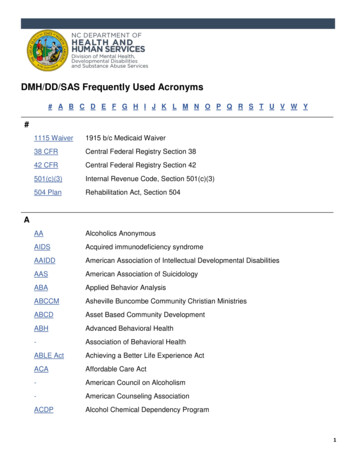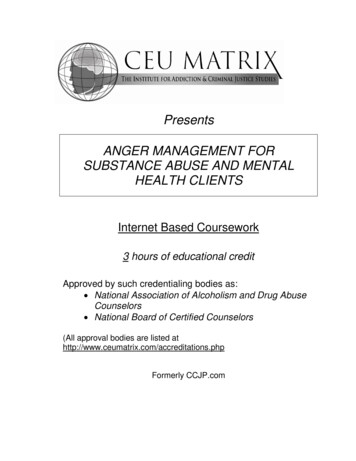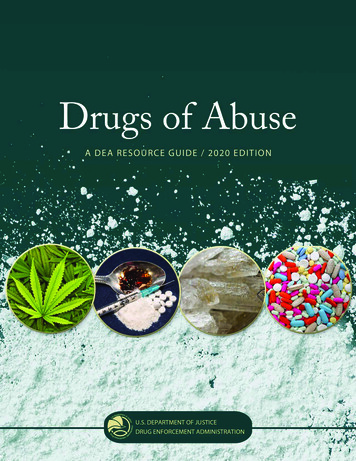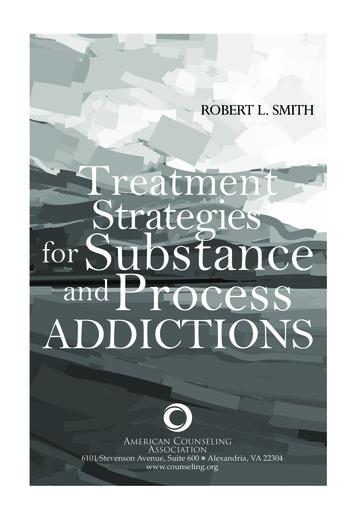
Transcription
ROBERT L. CTIONSAMERICAN COUNSELINGASSOCIATION6101 Stevenson Avenue, Suite 600 Alexandria, VA 22304www.counseling.org
SCopyright 2015 by the American Counseling Association. All rights reserved.Printed in the United States of America. Except as permitted under the UnitedStates Copyright Act of 1976, no part of this publication may be reproduced ordistributed in any form or by any means, or stored in a database or retrievalsystem, without the written permission of the publisher.10987654321AMERICAN COUNSELING ASSOCIATION6101 Stevenson Avenue, Suite 600Alexandria, VA 22304Carolyn C. BakerASSOCIATE PUBLISHERDIGITAL AND PRINT DEVELOPMENT EDITORPRODUCTION MANAGERCOPY EDITORNancy DriverBonny E. GastonBeth CihaCover and text design by Bonny E. Gaston.LIBRARY OF CONGRESS CATALOGING-IN-PUBLICATION DATATreatment strategies for substance and process addictions/[edited by] Robert L.Smith.p.; cm.Includes bibliographical references and index.ISBN 978-1-55620-353-4 (pbk.: alk. paper)I. Smith, Robert L. (Robert Leonard), 1943– , editor. II. American CounselingAssociation, issuing body.[DNLM: 1. Substance-Related Disorders—therapy. 2. Behavior, Addictive—therapy. 3. Evidence-Based Practice—methods. WM 270]RC564362.29—dc232015002551
This text is dedicated to the individuals and families who have experiencedsubstance and process addictions and to the courageous mental health professionalsdevoted to working and conducting research in treating addictions.—Robert L. Smithiii
TABLE OF CONTENTSPREFACEABOUT THE AUTHOR/EDITORABOUT THE CONTRIBUTORSACKNOWLEDGMENTSCHAPTER 1ADDICTIONS: AN OVERVIEWixxixiiixv1Robert L. SmithStudent Learning OutcomesCase and Case DiscussionAddiction DefinedCriteria for AddictionSubstance and Process AddictionsThe Prevalence of AddictionsThe Etiology of AddictionsTreatment 18252728ALCOHOL ADDICTION33CHAPTER 2Todd F. LewisStudent Learning OutcomesCase and Case DiscussionOverview of Alcohol AddictionAssessment and DiagnosisTreatment SettingsEvidence-Based Research: Treatment of AlcoholismArmed Services Substance Abuse Treatment ProgramsHospital Treatment ProgramsThe Matrix 849515151v
Table of ContentsCHAPTER 3NICOTINE ADDICTIONRobert L. SmithStudent Learning OutcomesCase and Case DiscussionOverview of Nicotine AddictionDiagnosis of Nicotine AddictionTreatment of Nicotine AddictionTreatment Guidelines for Evidence-Based PracticesConclusionsResourcesReferencesCHAPTER 4MARIJUANA ADDICTIONRichard S. BalkinStudent Learning OutcomesCase and Case DiscussionOverview of Marijuana AddictionAssessment and DiagnosisTreatmentModels and ApproachesEvidence-Based ResearchConclusionsResourcesReferencesCHAPTER 5METHAMPHETAMINE ADDICTIONHelena G. RindoneStudent Learning OutcomesCase and Case DiscussionOverview of Methamphetamine AddictionEffects of MethamphetaminesAddiction to 9398101103119120120PRESCRIPTION DRUG ADDICTION127Todd F. LewisStudent Learning OutcomesCase and Case DiscussionOverview of Prescription Drug AddictionAssessment, Diagnosis, and Treatment SettingsTreatment of Prescription Drug 3138143144145CHAPTER 6CHAPTER 7vi57PATHOLOGICAL GAMBLINGStephen Southern and Katherine HiltonStudent Learning OutcomesCase and Case DiscussionOverview of Pathological GamblingSpecial Populations of Pathological Gamblers149149149150153
Table of ContentsDiagnosis and AssessmentEmpirically Supported TreatmentsTreatment Packages for Pathological GamblingConcurrent Treatment of Trauma andPathological GamblingIntegrative Treatment in the Case of SarahConclusionsResourcesReferencesCHAPTER 8SEXUAL ADDICTIONStephen Southern, Dawn Ellison, and Mark HagwoodStudent Learning OutcomesCase and Case DiscussionOverview of Sexual AddictionSpecial Populations of Sexual AddictsDiagnosis of Sexual Addiction andHypersexual DisorderAssessment MethodsTreatment of Sexual Addiction andHypersexual DisorderIntegrative Treatment Package for Sexual Addictionand Life TraumaIntegrative Treatment in the Case of SarahConclusionsResourcesReferencesCHAPTER 9DISORDERED EATINGTamara Duarte and Fredericka DeLeeStudent Learning OutcomesCases and Case DiscussionOverview of Disordered EatingDiagnosisAssessmentTreatment Models and ApproachesConclusionsResourcesReferencesCHAPTER 10 WORK ADDICTIONSummer M. ReinerStudent Learning OutcomesCase and Case DiscussionOverview of Work AddictionWork Addiction Around the WorldImpact of Work AddictionAntecedents of Work AddictionDefinitions, Costs, and DemographicsAssessment and DiagnosisTreatmentModels and ApproachesEvidence-Based 256vii
Table of ContentsResourcesReferencesCHAPTER 11 EXERCISE ADDICTION256257263Michele KerulisStudent Learning OutcomesCases and Case DiscussionOverview of Exercise AddictionExercise Addiction and Exercise DependenceExercise and Disordered EatingInpatient and Outpatient Treatment SettingsEvidence-Based Models and 266267270271273274274CHAPTER 12 COMPULSIVE BUYING/SHOPPING ADDICTION277Kimberly FrazierStudent Learning OutcomesCase and Case DiscussionOverview of Compulsive Buying/Shopping AddictionAssessment and DiagnosisThe Brain and Compulsive Buying/Shopping AddictionTreatment ApproachesConclusionsResourcesReferencesCHAPTER 13 INTERNET ADDICTIONJoshua C. WatsonStudent Learning OutcomesCase and Case DiscussionOverview of Internet AddictionAssessment and APTER 14 ADDICTIONS: STATUS, RESEARCH, AND FUTURERobert L. SmithStudent Learning OutcomesCases and Case DiscussionCommon Features and Components ofAssessment and TreatmentIssues Related to AddictionsResearch and Evidence-Based TreatmentThe FutureTreatment in ContextAdditional 15317321323323324325326329
PREFACEThis text describes treatment strategies for working with substance and processaddictions. The content of this text goes beyond an introduction to the field ofaddictions by examining treatment approaches, many of which are evidencebased. The contributors, each of whom has clinical experience working with addictions, have thoroughly researched the most current treatment strategies. Readers will find this text a viable option for introductory courses on addictions orfor the second course in a sequence of classes in addictions counseling. Studentsand practitioners will find this book useful in understanding the link betweensubstance and process addictions as well as identifying recommended evidencebased treatment practices.This book addresses strategies and treatment programs often used with addictions to alcohol, tobacco, cannabis, amphetamines, and prescription drugs.Although a large number of substances are misused, these five represent someof the most prevalent substance addictions. Yet many of the interventions covered in this text can also be successfully applied to other substance addictions.An overview of additional drug addictions treatments is available in a numberof textbooks (Capuzzi & Stauffer, 2008; Doweiko, 2012; Stevens & Smith, 2013).A unique and significant feature of this book is its inclusion of full chaptersdevoted to the major process addictions, often referred to as behavioral addictions.The process addictions covered include gambling, sex, food, work, exercise,shopping, and Internet use. Strategies and treatment programs used with theseprocess addictions are emphasized. This focus on process addictions is timely,as recently researchers, professional groups, and government agencies (e.g., theAmerican Society of Addiction Medicine, National Institute on Drug Abuse,American Psychiatric Association, and Substance Abuse and Mental Health Services Administration) have recognized similarities between process addictionsand substance addictions, especially as related to mechanisms in the brain. Thisrecognition has led experts to consider both substance and process addictions asa type of brain disease. This text aims to provide clinicians at all skill levels witha reference for understanding the evolving field of substance and process addic-ix
PREFACEtions. In addition, the contributors provide readers with links to supplementalWeb-based materials to further enhance comprehension of substance and processtreatment, addiction, and supports.REFERENCESCapuzzi, D., & Stauffer, M. D. (Eds.). (2008). Foundations of addictions counseling. Boston,MA: Allyn & Bacon.Doweiko, H. (2012). Concepts of chemical dependency (8th ed.). Belmont, CA: Brooks/Cole.Stevens, P., & Smith, R. (2013). Substance abuse counseling: Theories and techniques (5th ed).New York, NY: Prentice Hall.x
ABOUT THE AUTHOR/EDITORRobert L. Smith, PhD, NCC, FPPR, author and editor, is the departmentchair and professor in the Counseling and Educational Psychology Department at Texas A&M University–Corpus Christi. He is the 63rd president ofthe American Counseling Association (2014–2015). He serves as the executivedirector and cofounder of the International Association of Marriage and FamilyCounselors. He is also a founder of the National Credentialing Academy forFamily Therapists. He completed his doctorate at the University of Michigan.As a nationally certified counselor and licensed psychologist, he has workedas a private practitioner in addition to serving as the department chair in threeuniversity settings. He has worked with a variety of addiction cases in privatepractice, consulted with the U.S. Navy in the area of substance abuse, andauthored several books and close to 100 professional articles. He is the coeditor of the text Substance Abuse Counseling: Theory and Practice, which is in itssixth edition. He is a counseling fellow of the American Counseling Association,a diplomat-fellow in psychopharmacology with the International College ofPrescribing Psychologists, and a consultant with the Substance Abuse Programin the U.S. Navy. As an international lecturer, Dr. Smith is currently involvedin the development and implementation of graduate programs in counselingand psychology in Latin America.xi
ABOUT THE CONTRIBUTORSRichard S. Balkin, PhD, LPC, is professor and coordinator of the Doctoral Program inCounseling at the University of Louisville. He completed his doctorate at the Universityof Arkansas. He has worked in private clinics and hospital settings with a number ofclients diagnosed with an addiction.Fredericka DeLee, PhD, LPC, is a professional counselor in private practice workingwith a wide range of client problems, including eating disorders. She resides in SanAntonio, Texas.Tamara Duarte, MS, is a professional counselor in private practice with a specialty infood addictions. She resides in Seattle, Washington.Dawn Ellison, PhD, is a clinical professor in the Doctor of Professional Counselingprogram at Mississippi College. She works as a clinician treating a variety of mentalhealth problems.Kimberly Frazier, PhD, NCC, is an assistant professor in the Counseling and Educational Psychology Department at Texas A&M University–Corpus Christi. In additionto having clinical experience, she has authored a number of professional articles andtextbook chapters.Mark Hagwood, PhD, is a graduate of the Psychology and Counseling Department atMississippi College. He is in private practice at Turning Point Counseling Services inRidgeland, Mississippi, specializing in addiction treatment.Katherine Hilton, PhD, DPC, LPC, is a clinical professor in the Doctor of ProfessionalCounseling program at Mississippi College.Michele Kerulis, PhD, LPC, CC-AASP, is the director of the Sport and Health PsychologyProgram at the Adler School of Professional Psychology in Chicago. She has extensiveclinical and teaching experience in the area of sport and health psychology.Todd F. Lewis, PhD, LPC, NCC, is an associate professor of counselor education at NorthDakota State University. He also served in this capacity in the Counseling and Educational Development Department at the University of North Carolina at Greensboro.In addition to having clinical experience, he has taught and authored articles in thearea of drug addictions.xiii
ABOUT THE CONTRIBUTORSSummer M. Reiner, PhD, LMHC, NCC, is an associate professor in the Department ofCounselor Education at The College at Brockport, State University of New York. Inaddition to having clinical experience in counseling, she is the author of numerousarticles and textbook chapters.Helena G. Rindone, MS, is a faculty member in the Counseling Department at the University of Wisconsin–River Falls and a doctoral candidate at Texas A&M University–CorpusChristi. She has an extensive history of working with clients with drug addictions.Stephen Southern, EdD, LPC, is professor and chair in the Department of Psychology andCounseling at Mississippi College. Over close to 35 years he has integrated the roles ofclinician, supervisor, consultant, administrator, and educator. He has also served as aclinical consultant to several hospitals and residential treatment centers in the UnitedStates and China.Joshua C. Watson, PhD, LPC, is an associate professor in the Counseling and EducationalPsychology Department at Texas A&M University–Corpus Christi. In addition to having clinical experience, he is a prolific author of professional articles, book chapters,and textbooks.xiv
ACKNOWLEDGMENTSI wish to thank the professors and practitioners who will be using this text alongwith those who provided feedback during its publication process. Without theinsight and wisdom of professionals in the field of addictions, this text wouldnot have been possible.Thanks to Carolyn Baker and the publications team at the American CounselingAssociation for pressing to keep timelines and for carefully editing this text. Theirsupport and encouragement are very much appreciated. In addition to the staffof the American Counseling Association, I would also like to thank two doctoralstudents, Shanice Armstrong and Rachel Henesy, for their assistance with this text.Special thanks go out to the contributors for their expertise and patience.Their clinical experience, research savvy, and writing skills are what make this astate-of-the-art text that emphasizes treatment strategies for both substance andprocess addictions.xv
Michele Kerulis, PhD, LPC, CC-AASP, is the director of the Sport and Health Psychology Program at the Adler School of Professional Psychology in Chicago. She has extensive clinical and teaching experience in the area of sport and health psychology. Todd F. Lewis, PhD, LPC, NCC,



